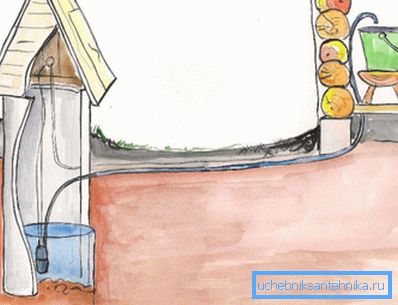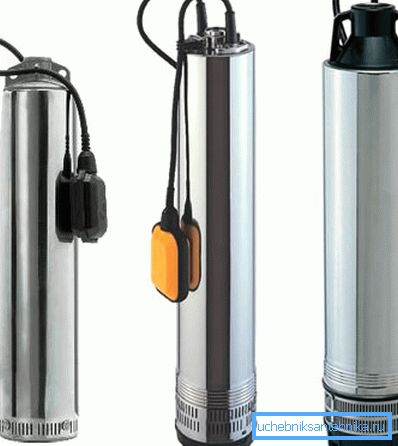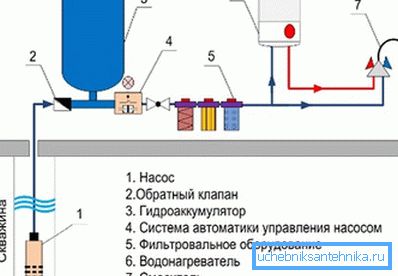How to draw water from the well to the house by yourself
In order to make water supply of a private house from a well with your own hands, you first of all need a 220V power supply without any special drops. This condition will allow you to connect an electric pump for automatic feeding - at the moment such units from other energy sources do not work.
We will tell you about the whole installation process below, and also see the thematic video in this article.

Automatic water supply to the house
About pumps

- The most common electric pump for automatic water supply from a well can be called a hydrophore, although, frankly speaking, it is difficult to explain its popularity. We will not analyze its device in detail, but we will only say that the unit itself is on the surface, most often it is a special pit in the house, and a hose is lowered into the well. It turns out that the pump pumps out the water and feeds it through itself into another hole, from which the wiring is already done.
- In no case can we say that the device itself is bad, especially if the instructions for installing it are fully observed, but there are still some unpleasant nuances. For example, the hose from the pump to the well (usually polyethylene d32 mm) should be biased - in the event of a counter-tilt in this area, the whole process may stall - the impeller will turn idle. Also, it is not very convenient to start it at the first start - you need to pour water into the hose going to the well, otherwise, again, the impeller will turn idle, but now for the reason that it will not beat water, but air.

- Submersible pumps look much more attractive in this respect, which for some reason sometimes unfairly bypass, perhaps due to the fact that their price is higher and this confuses some. But it is better to consider the cost of the final costs and then it turns out that such units are much more profitable than hydrophores - they are not so demanding in installation and rarely fail.
- Although there may be a problem, if you take water from a narrow well - the diameter of the pump may be 100 mm or more. But the wells are often made precisely from the hundredth pipe, therefore, it may be a situation that you have to use hydrophore.
Note. The submersible pump for the well should be selected so that it does not enter closely, but there is a gap of at least 10–20 mm between it and the pipe wall.
Assembly work

The water supply system of a private house from a well is quite simple, you just need to follow the connection sequence specified in the documents. First of all, you need to determine the distance from the house to the water source in order to purchase a sufficient 32 mm polyethylene hose, taking into account its descent. You also need to determine the required pump power, but, as a rule, all units are suitable for domestic purposes. (See also the article How to equip a well yourself.)
In the data sheet of the unit it is written how many cubes of water it can pump out in one hour, so it will be easy for you to determine your needs, because water may be needed not only for cooking and washing, but also for watering the garden plot.
But in this case, it is important to take into account the debit of the well from which water will be pumped out - is it able to restore the pumped volume without delay
If not, then the unit should be chosen weaker - if the water mirror falls below the pump, then it simply blows from idle, that is, in any case, the device itself must be constantly in the water.

From the well to the house you need to dig a trench for a polyethylene water pipe and electrical cable. Usually they dig it with a bias towards the water source, although for a submersible pump it is not of decisive importance. (See also the article Which Pump is Better for a Well: Choice Features.)
You will also have to make a hole in the foundation and the concrete circle of a well well, just try to do it as carefully as possible so as not to break a large hole.
A pipe in a trench is necessarily laid on a sand cushion, and after that it is filled with sand - it is an indispensable condition that the ground does not damage it during a subsidence. But the sand should sink well and in order to speed up this process, just pour water abundantly on it - a subsidence occurs immediately after watering.

Now pay attention to the photo above to properly observe the sequence when connecting, and first of all we install a check valve immediately after the pump, regardless of whether it is a well or a well.
Insert a piece of PVC pipe into the hole of the well ring to let the hose pass through it, and at the same time carefully seal everything up with a solution to prevent groundwater flow. At the exit from the well in such cases a special cap is installed.
A backup hydraulic tank is installed in the house, and since the service life of the pump directly depends on the number of inclusions, it is better to choose a larger capacity, but not more than 100 liters - for domestic purposes this is quite enough.
This is followed by a pressure switch and a dry-running sensor, which can be sold as one unit, or they can be sold separately. The second option is somewhat cheaper, besides practice shows that it is easier to regulate them separately.
The last step is to install a pressure regulator, setting it slightly lower than the pressure to start the pump - this will equalize the pressure, regardless of the pressure to the regulator and the on or off state of the pump.
And now, attention, the factory settings assume that the relay will be turned on at 2 bars, and off at 3 bars. This difference is optimal for small hydraulic tanks, but reduces the life of the pump itself, therefore, this gap can be increased from 1.8 bar to 5 bar, respectively, and the pressure regulator by 1.5 bar. To connect all the nodes we use polypropylene, as the most optimal variant of the pipe in this case. (See also the article Features of the replacement of the pump in the well.)

Note. Such units are sensitive to voltage drops, so if you have such problems on your power lines, use a voltage stabilizer. If you install it on the whole house, you will have to take into account the power of all current collectors, but you can install it directly in front of the relay.
Conclusion
For automatic water supply it is extremely difficult to say that it is better - a well or a well for a house, because water will always be the same in one area and there is only a slight difference in the installation.
Of course, the well can be drilled directly in the house during its construction, but the end result will still be the same and it will not affect the quality of operation. So such a question is likely to be attributed to the aspect of personal preference.